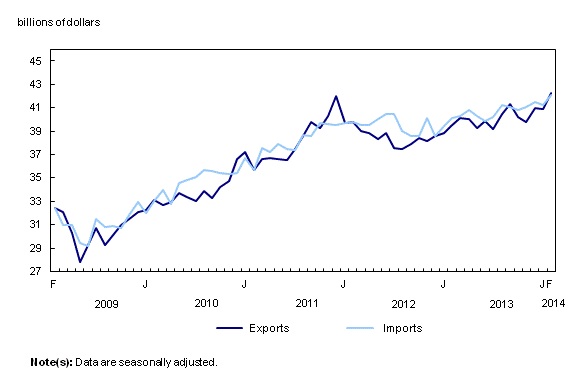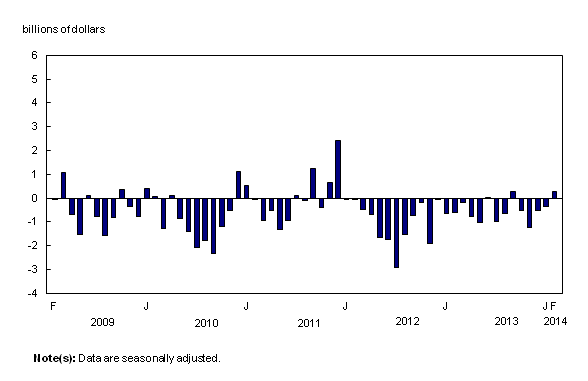Canadian international merchandise trade, February 2014
Archived Content
Information identified as archived is provided for reference, research or recordkeeping purposes. It is not subject to the Government of Canada Web Standards and has not been altered or updated since it was archived. Please "contact us" to request a format other than those available.
Released: 2014-04-03
Canada's merchandise exports grew 3.6% and imports were up 2.1% in February. As a result, Canada's trade balance with the world went from a deficit of $337 million in January to a surplus of $290 million in February.
Exports increased to $42.3 billion on the strength of motor vehicles and parts as well as energy products. Overall, volumes were up 2.2% and prices, 1.4%.
Imports grew to $42.1 billion, as prices increased 1.4% and volumes were up 0.6%. Higher imports of energy products, motor vehicles and parts, as well as industrial machinery, equipment and parts were partially offset by lower imports of metal and non-metallic mineral products.
Exports to the United States rose 4.4% to $32.4 billion on higher exports of motor vehicles and parts, and energy products. Imports from the United States increased 3.3% to $28.1 billion on the strength of motor vehicles and parts. Consequently, Canada's trade surplus with the United States increased from $3.9 billion in January to $4.3 billion in February.
Exports to countries other than the United States were up 1.1% to $9.9 billion. Increases in exports to the European Union (+6.8%) and Japan (+12.0%) were partially offset by declines to the principal trading area "all other countries" (-3.8%). Imports from countries other than the United States edged down 0.2% to $14.0 billion. As a result, Canada's trade deficit with countries other than the United States narrowed from $4.2 billion in January to $4.0 billion in February.
Motor vehicles and parts, and energy products lead gain in exports
Exports of motor vehicles and parts rose 9.7% to $5.7 billion in February after recording an 11.3% decline in January following extended holiday shutdowns at certain manufacturing plants in the United States and Canada. Higher exports of motor vehicle engines and motor vehicle parts (+24.2%) and passenger cars and light trucks (+5.6%) were the main contributors to the section's increase. Overall, volumes were up 8.4%.
Exports of energy products increased 4.3% to $11.2 billion, a third consecutive monthly gain. Crude oil and crude bitumen (+8.0%) led the section's monthly growth, but was partially offset by a decline in exports of natural gas (-12.2%). Overall, prices for energy products were up 6.0%.
Exports of farm, fishing and intermediate food products declined 6.8% to $2.3 billion in February following a 6.7% increase in January. Lower exports of wheat (-12.6%) and canola (-14.6%) both contributed to the decrease.
Imports up, led by energy products
Imports of energy products increased 7.3% to $3.9 billion in February, as volumes were up 6.0%. Imports of crude oil and crude bitumen, up 12.2% to $2.2 billion, led the overall increase. Also contributing to the increase was the commodity grouping "other energy products," which grew $69 million to $131 million on the strength of higher imports of coal.
Imports of motor vehicles and parts grew 3.0% to $7.0 billion, as all commodity groupings registered increases. Leading the way were imports of passenger cars and light trucks, which were up 3.7% to $3.0 billion in February, following extended holiday shutdowns in January.
Imports of industrial machinery, equipment and parts rose 4.4% to a record high $4.2 billion. The increase was attributable to higher imports of other general-purpose machinery and equipment (+12.0%), primarily conveyors. Overall, volumes increased 3.7%.
Partially offsetting the increases, imports of metal and non-metallic mineral products declined 5.6% to $3.4 billion, as volumes decreased 5.3%. The main contributor to the decline in imports was unwrought precious metals and precious metal alloys, which fell 25.6% to $564 million.
Canada's merchandise trade: An annual overview of 2013
Canada's total merchandise trade rose from $937.1 billion in 2012 to $966.5 billion in 2013. The percentage of total trade relative to Canada's gross domestic product of $1.879 trillion represented 51.4% in 2013. It has remained approximately at this level for the last three years, following a number of years of decline since the 71.9% peak in 2000. In 2013, exports rose 3.7% and imports increased 2.6%. Canada's annual trade deficit with the world narrowed to $6.8 billion in 2013 from a record $12.0 billion in 2012.
Canada's merchandise imports totalled $486.6 billion in 2013, as volumes grew 2.1% and prices rose 0.5%. A 5.1% increase in imports of consumer goods led the widespread growth in 2013. Gains were also recorded in imports of basic and industrial chemical, plastic and rubber products (+7.0%), aircraft and other transportation equipment and parts (+17.4%) and motor vehicles and parts (+2.6%).
Exports increased to $479.9 billion in 2013, as prices grew 2.1% and volumes rose 1.6%. The main contributor to the growth in exports was energy products, which rose 7.9% to $113.3 billion in 2013.
Canada's trade surplus with the United States grew from $42.0 billion in 2012 to $44.1 billion in 2013. Exports to the United States grew 6.0% to $358.8 billion and imports rose 6.1% to $314.7 billion. The share of Canada's exports to the United States increased from 73.2% in 2012 to 74.8% in 2013. The United States' share of total imports was 64.7% in 2013, up from 62.5% in 2012.
Canada's trade deficit with countries other than the United States went from $54.0 billion in 2012 to $50.9 billion in 2013. The trade deficit with the principal trading area "all other countries" narrowed in 2013, as imports declined 6.1% and exports grew 4.4%. Overall, imports from countries other than the United States fell 3.4% and exports declined 2.4%.
Note to readers
Merchandise trade is one component of Canada's international balance of payments (BOP), which also includes trade in services, investment income, current transfers as well as capital and financial flows.
International merchandise trade data by country are available on both a BOP and a customs basis for the United States, Japan and the United Kingdom. Trade data for all other individual countries are available on a customs basis only. BOP data are derived from customs data by making adjustments for factors such as valuation, coverage, timing and residency. These adjustments are made to conform to the concepts and definitions of the Canadian System of National Accounts.
Data in this release are on a BOP basis, seasonally adjusted and in current dollars. Constant dollars are calculated using the Laspeyres volume formula (2007=100).
For more information on seasonal adjustment, see "Seasonal adjustment and identifying economic trends."
Revisions
In general, merchandise trade data are revised on an ongoing basis for each month of the current year. Current year revisions are reflected in both the customs and BOP based data.
The previous year's customs data are revised with the release of the January and February reference months as well as on a quarterly basis. The previous two years of customs based data are revised annually and are released in February with the December reference month.
The previous year's BOP based data are revised with the release of the January, February and March reference months. To remain consistent with the Canadian System of macroeconomic accounts, annual revisions will take place in December with the October reference month rather than in June, as was previously the case.
Factors influencing revisions include late receipt of import and export documentation, incorrect information on customs forms, replacement of estimates produced for the energy section with actual figures, changes in classification of merchandise based on more current information, and changes to seasonal adjustment factors.
Revised data are available in the appropriate CANSIM tables.
These data are now available in the Canadian International Merchandise Trade Database (Catalogue number65F0013X). From the Browse by key resource module of our website, choose Publications.
The February 2014 issue of Canadian International Merchandise Trade, Vol. 68, no. 2 (Catalogue number65-001-X), is also now available from the Browse by key resource module of our website under Publications.
Data on Canadian international merchandise trade for March will be released on May 6.
Contact information
For more information, contact us (toll-free 1-800-263-1136; 514-283-8300; infostats@statcan.gc.ca).
To enquire about the concepts, methods or data quality of this release, contact Alec Forbes (613-951-0325), International Trade, Accounts and Statistics Division.
- Date modified:



